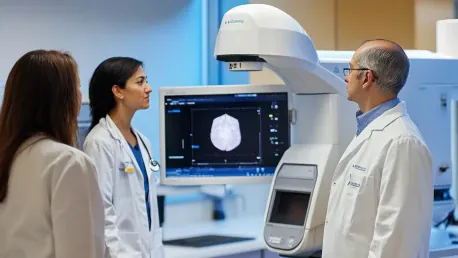Companion diagnostics have revolutionized the field of precision oncology by enabling the identification of patients who will benefit most from targeted therapies. Focusing on the genetic and molecular characteristics of an individual’s cancer, these diagnostics have significantly improved treatment outcomes and patient care. Over the past 25 years, advancements in companion diagnostics have been marked by rapid technological innovation and increased regulatory oversight, all striving to enhance the precision of cancer treatment.
The Evolution of Companion Diagnostics
The inception of companion diagnostics began with the FDA approval of the HercepTestTM for HER2 positive breast cancer. This transformative moment in oncology enabled targeted treatments for approximately 20 percent of women with this specific cancer type. This landmark event catalyzed exponential growth in the field, and currently, more than 60 companion diagnostics have been approved by the FDA, primarily for oncology applications.
Despite progress over the years, current diagnostic technologies face limitations when addressing tumor heterogeneity within and across patients. These limitations sometimes result in suboptimal treatment responses. The complexity of molecular processes driving cancer further highlights the need for more comprehensive diagnostic tools. Addressing tumor heterogeneity remains a critical challenge that necessitates ongoing innovation and improvement in diagnostic methodologies.
Technological Innovations in Companion Diagnostics
The initial wave of companion diagnostics leveraged Immunohistochemistry (IHC) in the late 1990s. Despite its continued use, IHC faces challenges such as variability in sample quality and subjective interpretation by pathologists. Improving existing technologies, as well as addressing the complexity and heterogeneity of tumor biomarkers, remains imperative. One significant limitation of current PD-L1 tests is their inability to recognize all protein forms, resulting in potential false negatives.
Molecular diagnostic techniques like polymerase chain reaction (PCR) and next-generation sequencing (NGS) have become essential in improving the sensitivity of detecting circulating tumor DNA. These technologies have significantly advanced the understanding of genetic drivers across various tumor types. However, they come with their own set of challenges. High costs and longer turnaround times affect the widespread adoption of NGS, while PCR faces constraints despite offering fast and sensitive results. The QIAGEN QIAstat-Dx platform exemplifies how newer technologies can deliver results more effectively, within an hour, with minimal training required.
Choosing between tissue-based diagnostics like IHC and sequencing technologies like NGS depends on several factors, including the biomarkers under consideration and the necessary turnaround time. The integration of these advanced techniques in clinical settings continues to ensure that diagnostics evolve to meet the needs of precision oncology.
The Role of Artificial Intelligence in Companion Diagnostics
Artificial Intelligence (AI) is poised to revolutionize companion diagnostics. AI facilitates sample analysis, helping quantify multiple biomarkers within a sample and differentiate between healthy and tumor cells. This technology shift aims to integrate multiple diagnostic modalities to create improved scoring systems, which include patient pharmacogenetics. Such advancements will provide optimized cancer treatment plans by personalizing medicine down to an individual’s unique biological profile.
AI also promises to expedite diagnostic processes significantly. By allowing algorithms to perform tasks quickly, testing, and treatment planning can be accelerated, ensuring patients receive the best possible care as promptly as possible. Additionally, the growing need for near-patient testing technologies that provide quick insights directly in clinical settings further underscores the importance of AI integration.
Examples from Europe and the United States show how AI is already shaping the future of companion diagnostics. France’s mandatory testing for dihydropyrimidine dehydrogenase deficiency before fluoropyrimidine chemotherapy exemplifies how personalized diagnostics play a crucial role in patient safety and treatment efficacy.
Navigating the Regulatory Landscape
Success in bringing companion diagnostics to market necessitates navigating stringent regulatory requirements. In Europe and the U.S., companion diagnostics are classified as high-risk in vitro diagnostic medical devices, requiring comprehensive validation. The synchronization of drug and diagnostic development is essential to ensure simultaneous market readiness, and coordination among regulatory agencies overseeing both drugs and diagnostics is crucial for timely product launches.
The introduction of the In Vitro Diagnostic Medical Devices Regulation (IVDR) in Europe has significantly impacted the landscape of development costs and timelines. IVDR imposes higher validation standards, challenging the rapid pace of innovation in diagnostics. Thus, a harmonized approach to regulations is essential to keep up with technological advancements while maintaining stringent safety and efficacy standards.
Collaboration and Commercialization
Robust collaboration between academic researchers and the pharmaceutical industry is indispensable for advancing companion diagnostics. Academic research plays a vital role in establishing technological standardization across different diagnostic test modalities, while pharmaceutical companies focus on commercialization to ensure widespread implementation and patient benefit.
An example of a successful collaborative effort is the Oncotype DX test for breast cancer. This PCR-based assay has gained widespread use among physicians, enabling them to tailor treatment plans based on the genetic profile of patients’ tumors. The continuous dialogue and partnership between academia and pharma have been instrumental in translating innovative research into clinical practice, thereby improving patient outcomes significantly.
Expanding Beyond Oncology
The methodologies and insights developed for oncology companion diagnostics are now finding applications in other medical fields. Companies are increasingly applying precision diagnostic approaches to address neurodegenerative diseases, inflammatory conditions, and autoimmune disorders. The foundational work in oncology not only set the stage for advancements in these areas but also highlighted the versatility and broader applicability of companion diagnostics.
The knowledge gained from oncology provides valuable experience in developing targeted therapies and corresponding companion tests for other complex conditions. This expansion marks a significant milestone, reflecting the potential of personalized medicine to transform patient care across a broader spectrum of diseases.
A Future of Precision Medicine
Companion diagnostics have transformed precision oncology by helping to pinpoint which patients will gain the most from targeted treatments. By focusing on the genetic and molecular properties of a tumor, these diagnostics have dramatically enhanced treatment results and patient care. Over the last 25 years, the field of companion diagnostics has seen remarkable advancements driven by swift technological innovation and greater regulatory scrutiny. These developments aim to improve the accuracy of cancer therapies, allowing for more personalized and effective treatment plans.
The advancements in companion diagnostics are not just technological; they involve a deeper understanding of cancer biology, which is critical for identifying specific biomarkers that guide therapy choices. Regulatory bodies like the FDA have increasingly streamlined the approval process to keep pace with rapid innovations while ensuring safety and efficacy. This has enabled quicker integration of new diagnostic tools into clinical practice, benefitting patients through more tailored approaches.
Additionally, the collaboration between pharmaceutical companies, diagnostic developers, and healthcare providers has been essential in achieving these milestones. As cancer treatments become more specialized, the need for precise diagnostics continues to grow, underscoring the importance of this evolving field in the landscape of oncology.









